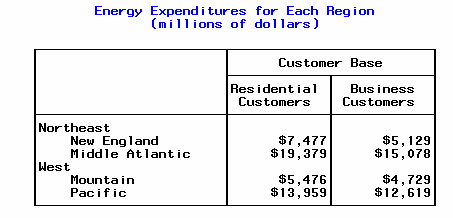TABULATE Procedure
- Syntax

- Overview
- Concepts
- Using
- Results
- Examples
 Creating a Basic Two-Dimensional TableSpecifying Class Variable Combinations to Appear in a TableUsing Preloaded Formats with Class VariablesUsing Multilabel FormatsCustomizing Row and Column HeadingsSummarizing Information with the Universal Class Variable ALLEliminating Row HeadingsIndenting Row Headings and Eliminating Horizontal SeparatorsCreating Multipage TablesReporting on Multiple-Response Survey DataReporting on Multiple-Choice Survey DataCalculating Various Percentage StatisticsUsing Denominator Definitions to Display Basic Frequency Counts and PercentagesSpecifying Style Elements for ODS OutputStyle PrecedenceNOCELLMERGE Option
Creating a Basic Two-Dimensional TableSpecifying Class Variable Combinations to Appear in a TableUsing Preloaded Formats with Class VariablesUsing Multilabel FormatsCustomizing Row and Column HeadingsSummarizing Information with the Universal Class Variable ALLEliminating Row HeadingsIndenting Row Headings and Eliminating Horizontal SeparatorsCreating Multipage TablesReporting on Multiple-Response Survey DataReporting on Multiple-Choice Survey DataCalculating Various Percentage StatisticsUsing Denominator Definitions to Display Basic Frequency Counts and PercentagesSpecifying Style Elements for ODS OutputStyle PrecedenceNOCELLMERGE Option - References
Example 8: Indenting Row Headings and Eliminating Horizontal Separators
| Features: |
PROC TABULATE statement options: NOSEPS TABLE statement options: INDENT= |
| Data set: | ENERGY |
| Formats: | REGFMT. |
Program
options nodate nonumber; ods listing;
proc tabulate data=energy format=dollar12. noseps;
class region division type;
var expenditures;
table region*division,
type='Customer Base'*expenditures=' '*sum=' '
/ rts=25 indent=4;
format region regfmt. division divfmt. type usetype.;
title 'Energy Expenditures for Each Region'; title2 '(millions of dollars)'; run;
ods listing close;
Program Description
Open the LISTING destination.The
INDENT argument does not indent nested row headings for HTML output.
The output will be captured as a listing with page numbering and date
turned off.
Specify the table options.The
FORMAT= option specifies DOLLAR12. as the default format for the value
in each table cell. NOSEPS eliminates horizontal separator lines from
row titles and from the body of the table.
Specify subgroups for the analysis.The CLASS statement identifies Region, Division,
and Type as class variables.
Specify the analysis variable.The
VAR statement specifies that PROC TABULATE calculate statistics on
the Expenditures variable.
Define the table rows and columns.The TABLE statement creates a row for each formatted
value of Region. Nested within each row are rows for each formatted
value of Division. The TABLE statement also creates a column for each
formatted value of Type. Each cell that is created by these rows and
columns contains the sum of the analysis variable Expenditures for
all observations that contribute to that cell. Text in quotation marks
in all dimensions specifies headings for the corresponding variable
or statistic. Although Sum is the default statistic, it is specified
here so that you can specify a blank for its heading.
